• Part 1: An Overview
• Part 2: Towns & Villages along the Canal du Midi
• Part 3: Best Places to Visit near the Canal du Midi
The Ultimate Guide to the Canal du Midi
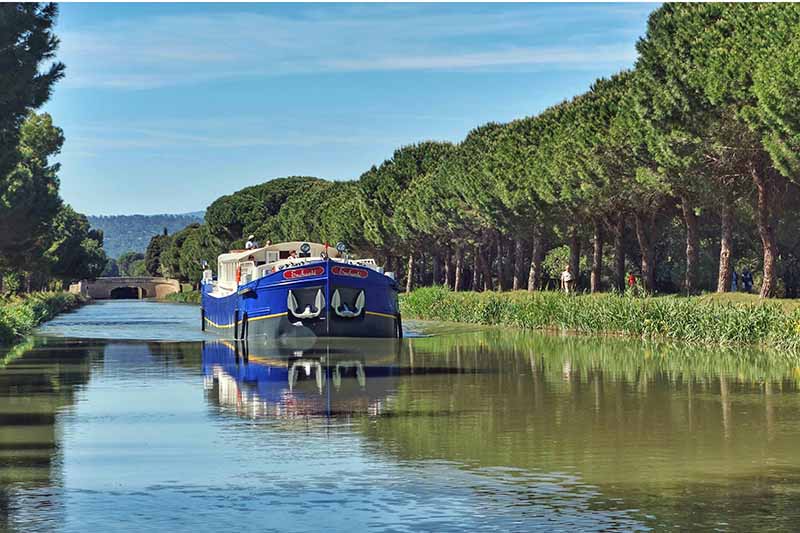
Part 1: The Canal du Midi – An Overview
Since Antiquity, a link between the Mediterranean and the Atlantic had long been sought by all those wishing to avoid the arduous journey around the Straits of Gibraltar. Augustus and Nero thought about it; Charlemagne considered it in the 8th century; François I and Leonardo da Vinci talked about it in 1516 but it took a wealthy salt tax collector in the 17th century to bring it to fruition.
Pierre-Paul Riquet (1604-1680) of Béziers supplied the vision, the drive, and even part of the financing for the Canal du Midi. In 1660 King Louis XIV’s chief financial advisor, Jean-Baptiste Colbert, noted that France’s international trade of wine and grain was in decline, and that both the Dutch and the Spanish were making the most of the situation. The crisis caused land values to fall and many small farms were going bankrupt. The Languedoc region was experiencing religious conflicts at this time, and was difficult to govern and, in particular, to collect taxes such as the salt tax.

Colbert saw Riquet’s proposal for the Canal du Midi as a way of pursuing economic expansion in the service of the Monarch in the Languedoc, and the idea was brought to the attention of the King in 1665. The canal offered the political and economic benefit of bypassing Gibraltar, which was controlled by the Spaniards, and would therefore destroy their trade and establish an alternative commercial route through the Languedoc. The Languedoc had many resources too, such as wheat, wine from Minervois and Corbières, woolen cloth, silk, and salt which producers were struggling to export due to lack of trade routes. By passing through the Canal du Midi, Colbert hoped to distribute goods in the different regions of the south, thereby strengthening royal power and opening up Toulouse and its region to the outside world.
In 1666 an edict by Louis XIV and Colbert proclaimed that construction could begin. Seven million cubic metres of earth were excavated for the project, which employed more than 12,000 men and women over a period of 12 years, a huge undertaking for its time.
The Canal du Midi was built not only to enable the more efficient transport of goods but also to help the military and add to the mobility of the French navy. Covering 150 miles, it includes 328 structures such as locks, tunnels, bridges, and aqueducts; the canal’s 63 locks include double, triple, quadruple and sextuple staircase locks.
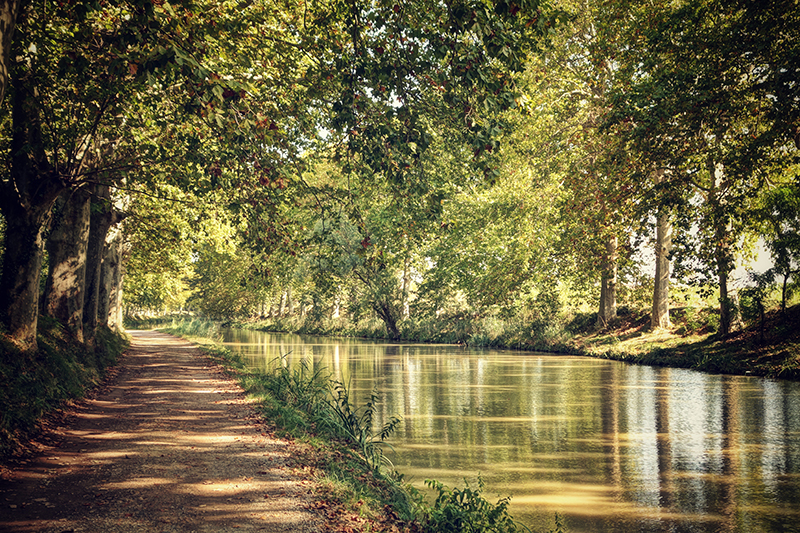
The canal has changed little in its 300 years. Lock gates are now steel rather than timber, an aqueduct was built to create a waterway over the River Orb in the 19th century and a short-lived water slope was built at Béziers to allow boats to avoid the six-rise flight of locks. In 1996 the canal was declared a World Heritage site by UNESCO.
The high quality of construction that went into the locks, aqueducts, and buildings has ensured that the Canal du Midi, the oldest canal in Europe, is still functioning, making it the most popular canal for leisure boaters in France.
The banks are lined with a variety of trees, mostly plane trees originally planted to provide shade to the haulage mules, and forming a huge green arc over the canal, often referred to as a “cathedral”. In recent years a malady affecting thousands of the plane trees which line the canal (and which contribute to its World Heritage status) has meant the slow but steady felling of all 40,000 along the waterway. The disease is believed to have been brought to France by ammunition boxes made of diseased wood, brought to France by American troops in the Second World War. The plane trees are being replaced with disease resistant varieties whilst some gaps have been left to allow wonderful vistas across to the Pyrenees.
Swimming is forbidden in the canal due to the danger from microbes carried by the rodents (in particular, coypu) which live in the roots of the trees in the banks.
Part 2: Towns & Villages along the Canal du Midi
The city of Toulouse is a major industrial and university city, with a rich history that is reflected in its architectural splendours.
Founded in the 13th century by Alphonse of Poitiers, Montgiscard was the royalist gathering point at the time of the insurrection in 1798 against the new republican rulers of France. The village was protected by the castle of Roqueville, which has been restored and is surrounded by a large park. Montgiscard’s 16th century church, with its cloister and remarkable wall-belfry, was a place of pilgrimage.
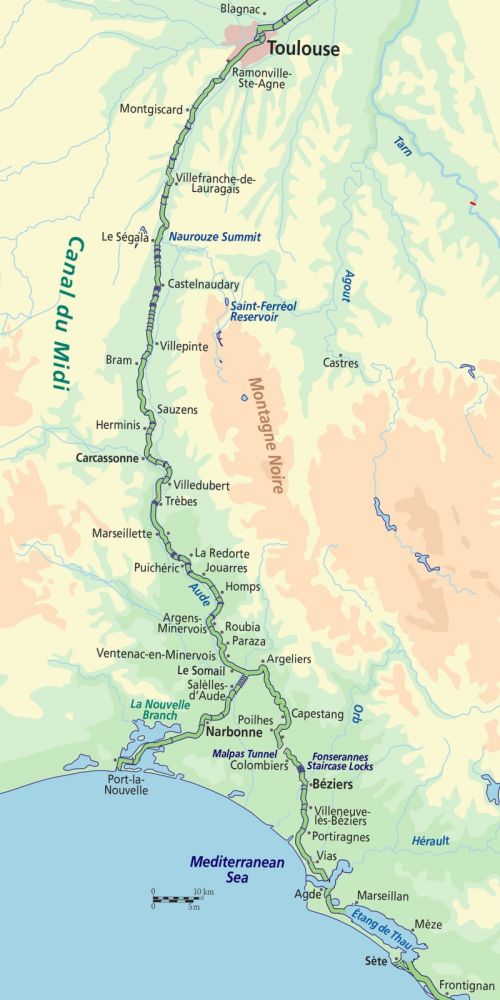
Castelnaudary’s name comes from the Occitan Castèlnòu d’Arri, a Latin translation meaning “Arrius’ new Castle”. The town was the location of a Roman staging post on the Narbonne-Toulouse Road. It is best known for its cassoulet, the famous and very tasty casserole for which it proclaims to be the world capital. Since August 2000 this dish has been celebrated every year during the Cassoulet festival.
At the request of the inhabitants of the town, the engineer responsible for the construction of the Canal du Midi, Pierre Paul Riquet, made Castelnaudary the technological heart of the canal with the construction of the Grand Bassin. At 7ha (17 Acres) it is the only stretch of water of its size along the whole waterway. The basin, which is a beautiful town attraction, was built as a port and a reservoir and features on one side the four-flight locks of Saint Roch and on the other, the island of Cybele, which in this incredibly windy part of the world acts as a windbreaker to the port. Throughout its working life, the Grand Bassin was constantly full of barges loading grain and wine bound for Sète and the Mediterranean, or Toulouse, Bordeaux, the Atlantic and ultimately, the world.
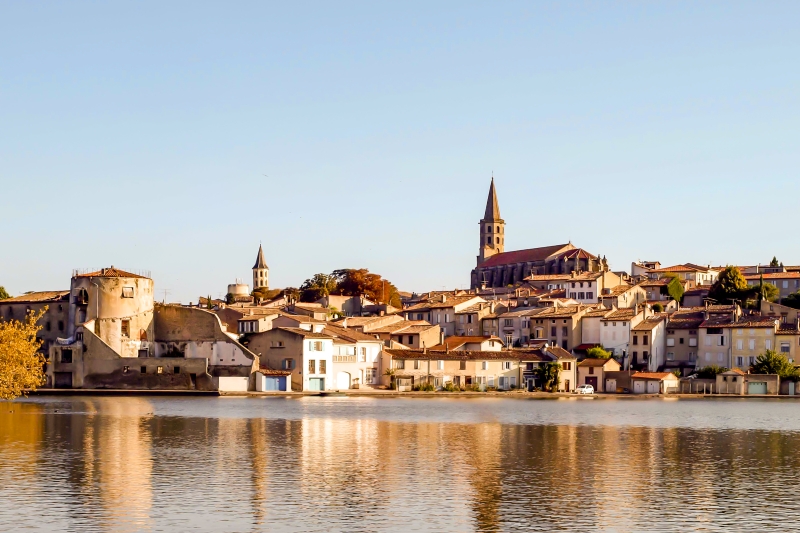
Villepinte is a small village on the banks of the Canal du Midi. As well as featuring one of the 91 locks along the canal, the village also houses the beautiful 9th century church of St-John the Baptist, which, since 1949 has been listed as an Historic Monument. With its origins dating back to the Gauls and the Romans, Villepinte today is presented as a typical medieval village with a maze of tiny, winding streets and a canal-side wash house.
Bram is a former bastide, or fortified town, which was founded by the Romans due to its location between the warmth of the Mediterranean and the freshness of the Atlantic. Roman remains suggest the town was not as circular as it appears today. The modern town was built in the 12th century around its castle and its church. The only way to enter the village was via a gateway in the eastern boundary of its ramparts.
In the 13th century the town was a centre of Cathar belief, the heretical Christian group which led to the Albigensian Crusade. In 1209, the Crusade’s then leader, Simon de Montford, came to Bram to pollute the waters of the citadel, whose wells were fed by a spring in the countryside around Bram. He besieged the town and succeeded in taking the town within three days. The heretics were captured and horrifically mutilated – all but one had their top lips cut off and their eyes gauged out, before being led on a forced march to the town of Lastours as a warning to others: turn yourselves in or await your fate. Later in the Crusades, Simon de Montfort turned to burning the Cathars alive, and so either way they did not get off easy!
By the 17th century the town had outgrown its walls and had expanded in concentric circles. During the working lifespan of the Canal du Midi, Bram was a centre for grain, wine and agriculture.
Carcassonne is a medieval fortified city set atop a hill overlooking the Aude River. Rising against the backdrop of the Black Mountains, the city is striking not only during the day but also at night, when it is floodlit. Composed of a circle of towers and battlements, turrets and ramparts, with the longest city wall in Europe, Carcassonne is a perfectly restored medieval town. The oldest sections of its encircling wall were built by the Romans in the third century AD. Its name dates from the 9th century, when the city was under siege by Charlemagne. Dame Carcas, in full view of Charlemagne, fed the last of the city’s wheat to pigs. Charlemagne, thinking the act signified an endless food supply for the city’s inhabitants, gave up and decamped. Credited with saving the city, Dame Carcas’ act led to the city being known as “The Virgin of Languedoc” and impregnable. Carcasonne’s Bastille Day fireworks display is one of the most spectacular in the region, against the backdrop of the old cite.
In the little town of Trebes, visitors will find numerous shops tucked away in a network of narrow streets. The town’s medieval church has seen recent renovations and expansions in both the 18th and 19th centuries. A false vault of plaster built on the nave’s ceiling built in 1860 partially collapsed in 1977. This incident was fortunate, however, revealing 350 painted faces on the wooden frame of the roof, which were then cleaned and restored. The painted figures represent characters in their daily life, with geometric and botanic patterns. This find is exceptional in the region, with the decor being complete.
Marseillette is a pleasant settlement of stone buildings. With a population of approximately 715 people, the income for the hamlet comes not only from wine but also from the production of rice. The ancient étang de Marsillette was drained in the 19th century by Anne-Marie Coppinger, a Dubliner who had settled in the region with her revolutionary husband John Lawless to evade the Irish Famine. She purchased the rights to the lagoon and within four years had cut three channels to drain the waters into the nearby Aude River. Unfortunately, the return from the lands within the lake were insufficient and she bankrupted herself with the project. In 1901 Joseph Camman, an engineer, bought 800 hectares of the étang and started a campaign to improve irrigation. He built a hydroelectric power station to regulate the flow of water and was eventually able to start cultivating the land. Today apples, vines and rice are grown in the salty, marshy lands around Marseillette.
The village of Puichéric, where barges encounter a two-pound lock on the Canal du Midi, has a square-towered church. In the village itself one can wander down to see the remnants of the old railway line – an old railway bridge and parts of the line – which once connected the Minervois to the Corbières (Caunes-Minervois to Moux). These vestiges can be found all over the region – at the town of Cruzy, a former station has been converted into a restaurant! Also in Puicheric are the remains of the 11th century château which was burnt down by marauding English under the Black Prince in the 14th century.
The quay at La Redorte is within walking distance of many shops and restaurants. An aqueduct nearby crosses the river Argent-Double. Close by is the unique épanchoir or spillway, which allows water from the canal to overflow into the river. It was added to the list of historic monuments in 1996.
The village of Homps has its origins in the Gallo-Roman period, when it was called Aldomus. It quickly developed to become a prosperous and flourishing town. In the Middle Ages, Homps passed under the authority of the Hospitaliers of the Order of Saint John of Jerusalem who made it the seat of one of their most important commanderies. The village was destroyed during the Albigensian Crusade, the fight against the Cathars, and suffered badly again during the Wars of Religion. With the construction of the canal, Homps had a turn for the better and once again became prosperous, becoming not only the third port on the canal but also one of the only places where barges could turn around. Wine making has long since been important to the town, and despite being ravaged by the Phylloxera blight, it was the centre of the cooperage industry in the region sending barges of wine to the ports of Bordeaux, Toulouse and Sète.
The hilltop settlement of Argens-Minervois is considered by many to be one of the most beautiful on the Canal du Midi. The village is dominated by the nearly windowless towers of its ancient 14th century castle, whilst cobblestone streets wind through its heart.
Roubia is a canal-side village built around a church that was rebuilt in 1929, after the original was destroyed by termites in 1918. When open, be sure to look inside to see a beautiful stained-glass window in the ceiling. The old port, where barges would load and unload barrels of wine, is a popular meeting place for many of the older inhabitants of the village.
A single-arched aqueduct, the first of its kind in the world, completed in 1676, carries the canal over the River Répudre at Paraza. On the outskirts of the town lies a château whose grounds are bordered by umbrella pines and palm trees, and where Pierre-Paul Riquet lived during the construction of this stretch of the canal.
One of the Midi’s prettiest villages, Le Somail grew up around a stone-arched bridge, le Pont de St-Marcel, built in the 17th century. Built as a “service station” for the canal, a former grain store (converted in the 18th century into a chapel) and an inn where the postal-barge running between Toulouse to Agde would change its horses, stand at either side of the bridge and the canal. Opposite the chapel, one can see the old ice-house where large blocks of ice would be stored to keep produce fresh during the hot summer months.
Le Somail also has one of four staging posts, similar to coaching inns, where scheduled passenger boats would make overnight stops as they plied between Agde and Toulouse in the 18th century.

The first village on the Canal de Jonction, a branch canal built in the 18th century and modified to allow larger boats to join the Canal du Midi from the Mediterranean in the 19th century is Sallèles d’Aude. An ancient The picturesque bridge over the Canal du Midi at Le Somail medieval village first mentioned in the 10th century, the majority of its buildings today date from between the 16thand 19th centuries. A former priory stands in ruins in the centre of the village. Nearby, an archaeological dig in the 1970s uncovered an incredible complex for the production of amphorae (large pots) bound for the Roman Empire.
On the edge of an ancient lagoon, Capestang’s name comes from the phrase “cap de l’étang”, meaning “at the top of the lake”. In the 13th century, the town was the preferred summer residence of the Archbishops of Narbonne, and a magnificent palace was built in the centre of the village during the 14th and 15th centuries.
The Great Hall’s ceiling timbers are decorated with 15th century frescoes whilst 14th century murals adorn the walls.
Opposite the Palace is the 13th century Collegial church of Saint Stephen. Built on the site of an earlier 11th century chapel, it was intended to rival the cathedral of Narbonne. Unfortunately, however, due to the plague of the mid-13th century, the antics of Edward the Black Prince and then the expulsion of Jews in France, construction halted, just as it did with the Cathedral of Narbonne.
Capestang is also notable for one of the lowest bridges on the Canal du Midi with only 10ft headroom. In November 1766, a 140ft segment of the bank collapsed after heavy rain and snow. Ten thousand workmen toiled for three months in freezing conditions to make repairs. Automatic siphon sluices were subsequently installed both here in Capestang and at Ventenac so water can excess drain off before flooding the banks. When the level of the water drops sufficiently, air is admitted into the pipes and the flow of water ceases.
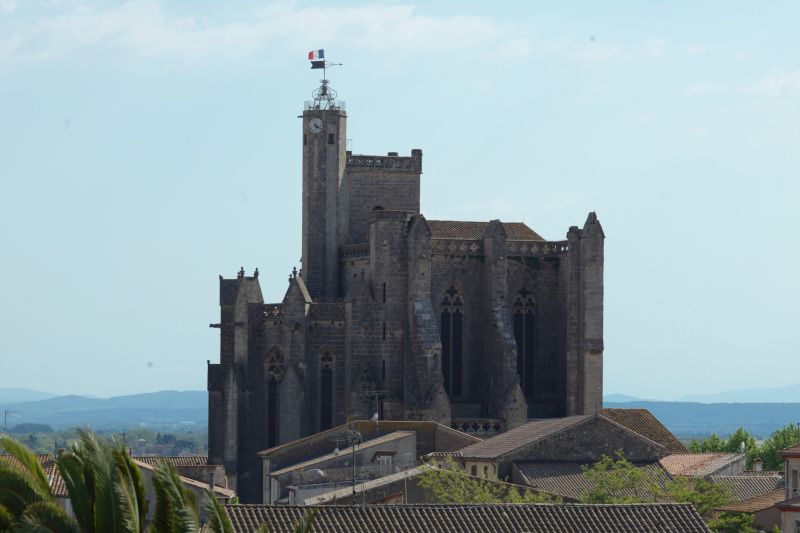
The village of Poilhes is divided in half by the Canal du Midi. In 1744, the canal at Poilhes was blocked by a landslide; within 14 days a retaining wall was built and navigation was restored. One of the region’s few beers, “La Gorge Fraîche”, is brewed on the banks of the canal in Poilhes and is a favourite of many a bargee. The label depicts none other than a barge on the Canal du Midi!
Between Poilhes and Colombiers lies the Malpas Tunnel, the world’s first section of navigable underground canal. At 525 feet, it is not particularly long, but it is wide and high. It is cut through sandstone, and most of the inside is lined with stone vaulting. Before the canal was built, Toulouse and Béziers were four days apart; with the arrival of the Canal du Midi they were only 32 hours away from each other. A towpath runs alongside the canal inside the tunnel. Local folklore suggests after the completion of the canal, one of the workers built a small nook inside the ceiling of the tunnel and lived as a hermit inside it. When barges pass through The Archbishop’s summer residence at Capestang is one of the most important buildings of the area Crew working on barges throw bread into the opening in the ceiling of the tunnel for the hermit the tunnel, captains and deckhands still sometimes throw a piece of bread into the opening of the nook as a “gift for the hermit”.
The canal tunnel, however, is not the only tunnel through the hill at Malpas. An earlier, 13th century, channel was tunnelled by monks at the nearby church of Montardy when draining the lake at its foot to eradicate the threat of typhoid and cholera arising from the stagnant waters. In the 19th century, a railway tunnel was also built underneath the canal. On the top of the hill lies the ancient Roman road, the Via Domitia, which linked Rome with the port of Narbonne, and eventually with Spain and North Africa.
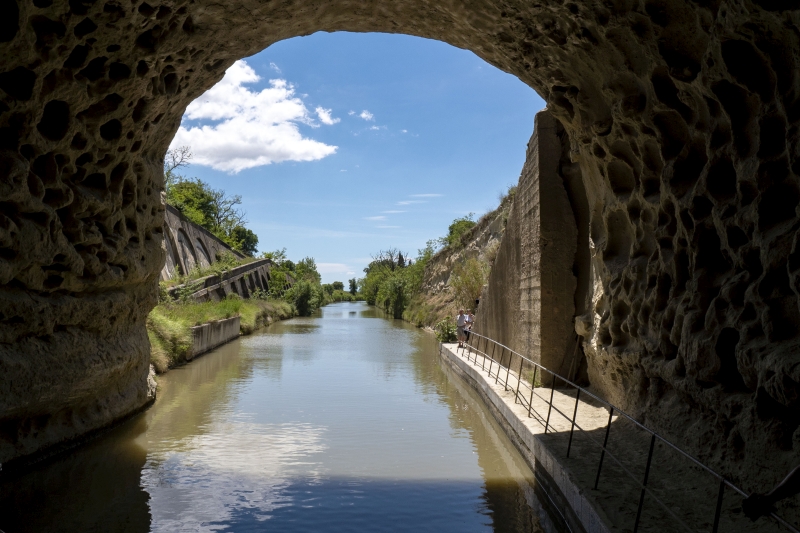
In the plain below the Oppidum d’Enserune Colombiers is a bustling little village on the banks of the Canal du Midi. It houses a beautiful Romanesque church which was first built under the reign of the Visigoths, and later expanded in the 10th and 11th centuries.
Béziers is one of the oldest cities in France, dating from around 575 BC. On July 22nd 1209, the city was attacked during the crusade against the Cathars, led by Pope Innocent III and the Bishop of Citeaux. The entire city was ransacked, and the old cathedral burned. The cathedral was later rebuilt and dedicated to Saint Nazarus. One of the bestpreserved towns in Occitanie, it is also the birthplace of engineer Pierre Paul Riquet, famous for overseeing the construction of the Canal du Midi.
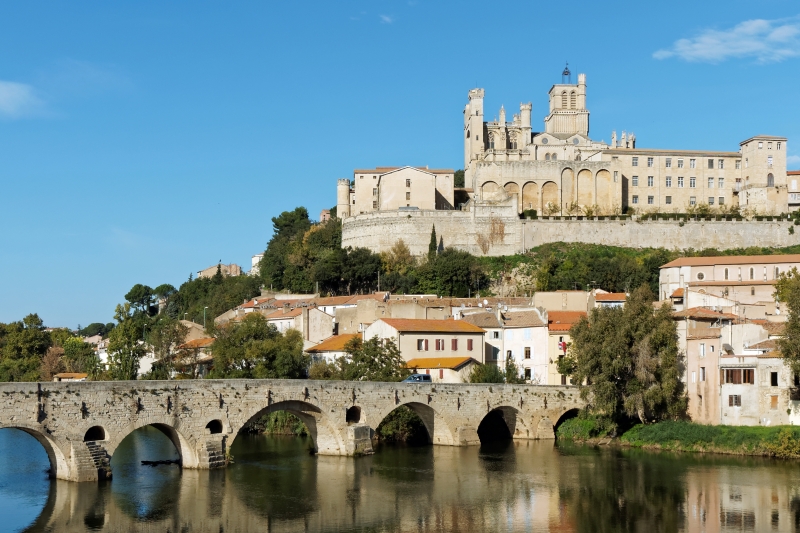
The Nine Locks of Fonserannes are the masterpiece of the Canal du Midi and Pierre Paul Riquet’s swan song. Following the engineering marvel of the Grand Bief (53km stretch without locks), he knew he had to come back down to sea level eventually and decided to do so in his hometown. The lock flight has recently been restored and today features a new visitor centre.
When the canal first opened, the locks helped boats descend on to the River Orb. Boats would then have to traverse the river before rising through a series of locks on the other side. This system was riddled with issues, however, as during the winter months boats were often swept off course due to the fast current, and in the summer, they would beach due to lack of water. In the mid-19th century, therefore, it was decided to build an aqueduct carrying the canal over the River, allowing for safe passage all the year round. The bridge opened in 1858 and has since become an iconic feature of the Canal du Midi.
As a result, the new port also opened the same year and the old port was abandoned. The canal was diverted before the seventh lock, blocking any further access to it. This meant that two new locks had to be built, as the last two in the lock flight were also out of action. These two new locks are the deepest on the Canal du Midi, each measuring a rise of over 6 metres!
Opposite to the lock flight one may notice an intriguing piece of engineering. The Fonserannes water slope opened in 1983 with the intention to allow commercial barges too large for the lock flight to enter the Grand Bief. However, after many technical issues, the water slope closed indefinitely in 2001.
The medieval town of Villeneuve-lès-Béziers was built on land which belonged to the emperor Charlemagne in 843. The town was built to house inhabitants of Béziers, which was quickly becoming overpopulated. A new church and town hall were built, forming the centre of the new town, from where the modern town gets its name.
Portiragnes is a canal-side village with a population of just over 3000 inhabitants. Although the site has been inhabited since prehistoric times, the modern-day village was founded in the 12th century. A maze of winding streets and tiny houses, it is a true medieval village. In its centre stands the church of Saint Felix, dating from the 13th – 14th centuries. Portiragnes lock is one of the few on the Canal du Midi that was upgraded to the Freycinet gauge of 40 metres. Here the canal is less than 2 miles from the Mediterranean Sea.
Vias is a small town close to the Canal du Midi. Like many other towns in the region, it was, during the Middle Ages, a “bastide”, or fortified town. Its ramparts are still visible today. On the edge of the old fortifications is the 14th century church, built in the Gothic style using the local volcanic stone, giving it a very dark appearance.
Agde is said to be one of the oldest towns in France. It was founded by the Phoenicians in the 6th century BC. The symbol of the town, the Ephebe of Agde, was recovered from the sandy floor of the River Hérault in 1964. It is thought that it was on its way to a villa in Narbonne when it was lost in a shipwreck. The town is built from black basalt, the primary building material of the area and the remnants of a now extinct volcano that once stood nearby.
Marseillan, like Agde, is another ancient settlement and was also founded by the Greeks. Today it is famous for its dry Vermouth Noilly Pratt and the oysters which grow in the salty waters of the lagoon beside which the town sits. The Étang de Thau is one of the largest saltwater lagoons in France and is separated from the Mediterranean by a thin strip of land running from Sète to Marseillan.
The centre of the village is a maze of winding streets and medieval buildings, including an ornate 13th century covered market and the 17th century church of Saint John the Baptist. Until the 18th century a fort stood in the centre of the village, flanked by watchtowers, gates and ramparts.
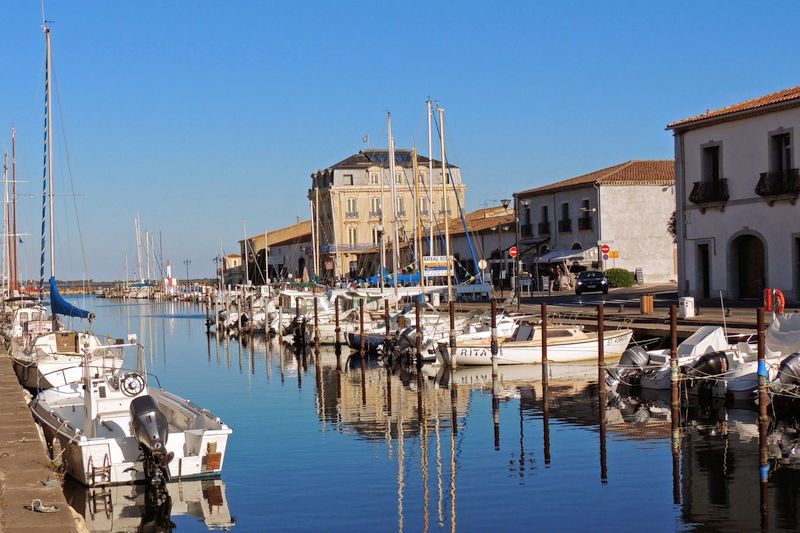
Part 3: Best Places to Visit
The Abbaye de Fontfroide was founded in 1145, on the site of an earlier Benedictine establishment, and soon developed into a highly respected and wealthy Cistercian abbey. One of its abbots became Pope Benedict XII in the 14th century.
The massive church, with its 65-foot-high roof, has the simple, clean lines typical of Cistercian abbeys and is entered via a 13th century cloister. It fell into decay as a result of the Plague of 1348 and was subsequently run by nobles who were given the courtesy title of Abbots without actually being monks. They added various luxuries such as fireplaces, elaborate staircases, and marble pillars in the cloister, which make parts of the abbey look more like a château than a religious establishment. In the monks’ dormitory, there is a display of collages made from fragments of glass rescued from bombed churches in eastern France after the First World War.
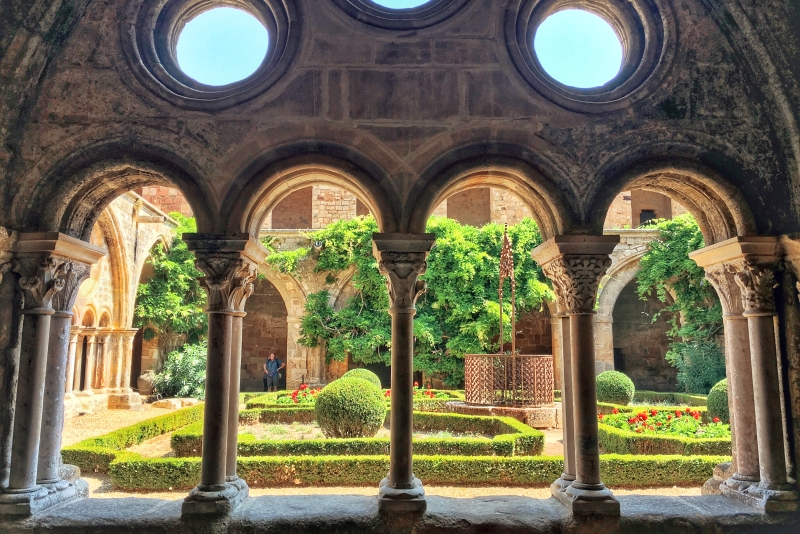
L’Oppidum D’Ensérune is a hilltop settlement close to the Canal du Midi, which has been declared the “most important pre-Roman settlement” in southern Europe by UNESCO. Greek and Iberian excavations, which date the settlement to 600 BC, have been unearthed, with later Roman additions found amongst the original foundations. Residential dwellings, shops, a town hall and workshops have been excavated across this vast site. Among other items, huge terracotta cisterns which stored wine, olive oil and water in the floors of the buildings, have also been unearthed. An archaeological museum displays the treasures of this extraordinary site. The settlement overlooks the Etang de Montady, an ancient lagoon which was drained by medieval monks by cutting radial ditches. The ditches all flow to the centre from where the water runs through an underground culvert under the same Malpas hill as the canal tunnel. The radial design creates a remarkable pattern of triangular field plots, unique to the region.
Overlooking the archaeological excavation site of a Gallo-Roman potter’s workshop the Amphoralis Museum describes the history of amphorae production in Sallèles d’Aude, which lasted from the 1st century BC to the 3rd century AD. The museum is divided into four sections, and details the production, firing, daily life and trade of the Roman potters, who mass-produced the earthernware vessels for the transportation of wine. Outside there are reconstructions of kilns and a potter’s village, as well as a garden which features over 900 plants which would have existed during the Roman period.
Lezignan-Corbières is a lively and friendly market town near the Canal du Midi which plays a pivotal role in the lives of the neighbouring Corbières and Minervois. It has a long history, appearing in a Carolingian document of 806 when it was called Licinianus. Built on a viticultural economy, the town houses the Vine and Wine Museum Lézignan’s and is also home to the Reyes family, better known as the Catalonian flamenco and salsa group, the Gispy Kings.
Sitting atop a rocky outcrop at the junction of the Cesse and Brian Rivers Minerve, the ancient capital of Minervois, is considered by many to be the quintessential medieval village. First founded in the 8th century, it is surrounded by deep limestone gorges and offers magnificent views of surrounding countryside. Along the riverbed are caves and bridges carved out of limestone by the power of the water. “La Candela,” an octagonal tower, is all that remains of the medieval castle. It is famously remembered as the site of the first mass-burning of Cathar heretics during the Albigensian Crusade of the 13th century. A small museum in the centre of the village recalls this gruesome chapter of its history. In the centre of the village, the 10th century church of St-Stephen houses a 5th century altar, which is thought to be one of the earliest Christian altars in Europe. It is inscribed with the initials and names of the inhabitants of the town, who swore to God they would pay their taxes whilst under Visigoth rule.
The seat of local Government for the Languedoc during the 16th and 17th centuries, Pézenas’ entire old town was one of the first in France to be protected as a state historic monument. It is rich with “hôtels particuliers” – private mansions – with wonderful wrought iron balconies, stone sculpture and ornate doorways. The interior of the Consular House dates back to 1552 and it is recorded that the consuls of Pézenas met on this site from 1242 until the Revolution in 1789. Today the town is famous as a market town, and artisans and craftsmen from all over the world come to Pézenas to create and sell their wares. One shop of particular interest is the silk-weaver’s workshop at the crossroads in the old town. A refugee from Damascus, he toils all day weaving beautiful silk scarves on a traditional 17th century loom – the only thing he took with him when he left Syria!
Pézenas is a town rich with the sort of good living that the Canal du Midi region is famous for. The Boudet family have been manufacturing “Berlingots de Pézenas”, a unique variety of hard boiled sweet, for many years. Legend has it that the recipe dates back to the time of the medieval fairs. Another specialty, the “petit pâté de Pézenas”, was brought to the town by Lord Clive of India in 1768. The recipe is proudly kept secret by the town’s bakers who to this day continue to produce the famous pastry.
The town has always been popular with actors, singers and all manner of performing artists. It was this love of the arts that attracted the famous French playwright Molière to Pézenas in the mid-1600s, after he was exiled from Paris. Molière is reputed to have created some of his famous characters in Pézenas while sitting in the barber’s shop (now the tourist office).
Narbonne was the first town outside of Italy to be colonised by the Romans and grew to be the second largest town in Gaul and the largest port outside Rome. Once a coastal port, it prospered until the sea receded in the Middle Ages. It is now eight miles inland. Today Narbonne has a well-restored medieval quarter and is famous for its magnificent art-nouveau covered food-market. A must visit for anyone cruising on the Canal du Midi
Buried deep below street level, the Roman Horreum is thought to be unique in antiquity. Part cold-store and part market, this subterranean maze was first discovered in the 1830s and was briefly used by residents as cellars. Staircases and tunnels were dug below ground giving them access to the many rooms it concealed. The Horreum has since been excavated and today gives a unique insight into the life of Roman Narbonne.
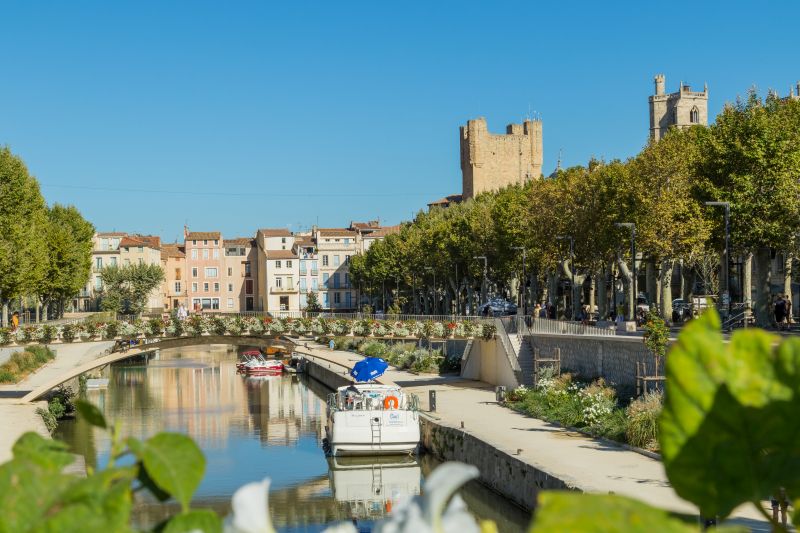
The Cathédral St-Just & St-Pasteur is the third tallest in France and is known for its beautiful stained glass, tapestries and organ. The famous French singer Charles Trenet was born in Narbonne, and some of his most popular songs are about the region. The house in which he was born is today open for visitors and a mural at the entrance of the town is dedicated to him.
Situated on the Mediterranean coast outside Narbonne, Gruissan lies in the heart of the Regional Park of Narbonne. A traditional fishing village, the town is laid out around its 10th century castle. Only one tower, locally known as the Tour Barberousse (Redbeard Tower) remains.
The Salt Flats of the Island of St-Martin are located close-by, in the lagoon of l’Ayrolle. Since antiquity, Gruissan has exploited its natural resources of salt. Although the method of harvesting the salt has evolved over time, it is still a crucial part of everyday life in Griussan with generations of salt-gatherers having lived in the village. The life of salt workers, and the work it entails, is explained by guided tours on the marshes. A museum also explains the history of salt-culture and the connection it has with the production and transportation of wine.
The awe-inspiring Gouffre de Cabrespine in the hills north of Carcassonne is one of the largest natural caves open to the public in the world. At over 1,600,000 m3 (56,503,466 ft3), it could fit Notre Dame de Paris or the Eiffel Tower inside. Formed over millions of years, it was only discovered in the 1970s by two local boys who found an entrance at the floor of the cave. Today visitors are guided in from an entrance at the top of the mountain in which it is situated. Rock including iron, marble, limestone and quartz can be seen throughout its walls. A sound and light show is played everyday, showing off its amazing acoustics.
One of the most “Beautiful Villages in France”, the medieval village of Lagrasse was home to one of the most important abbeys in the south of France. Founded in the 7th century, under a charter ordered by the Frankish King Charlemagne, the Abbey of Sainte-Marie d’Orbieu (named after the river which flows through the village) was originally built in the Romanesque style. The abbey soon became very wealthy, thanks to several large donations from noblemen of the area, and started to acquire lands, castles, priories and other assets. By the 12th century it ruled over a large territory encompassing the dioceses of Toulouse, Béziers and the County of Barcelona. In the early 13th century the Abbey had further improved its fortunes, in large due to bounties collected by crusaders during the Albigensian Crusades against the Cathars. Lagrasse should be on everyones list when cruising the Canal du Midi.
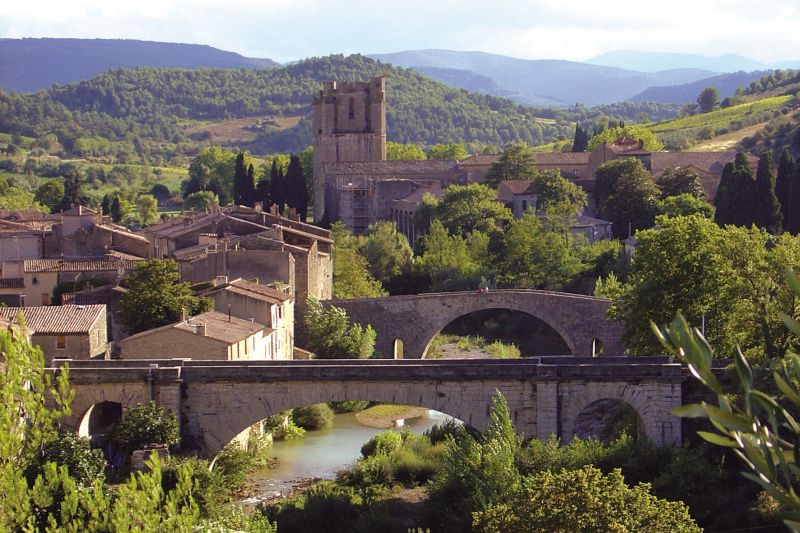
Its fortunes, however, began to decline during the 13th – 15th centuries during which it was reinforced and fortified to protect its riches from the numerous wars being fought, including the Hundred Years War and the Wars of Religion. The Abbey enjoyed a renaissance and received renovations, including a new cloister, under its penultimate abbot Armand Bazin de Bezons, before being forced to close during the French Revolution, after which it was put up for sale but never bought. In 2004 the Canons of the Mother of God moved into a portion of the abbey and still reside there today. The unoccupied area was purchased by the State of the Aude in 2007 and is currently undergoing restoration.
The Châteaux de Lastours are four so-called 11th century Cathar castles, situated approximately one mile from the village of Lastours. The castles are on a rocky spur high above the village, isolated by the deep valleys of the Orbeil and Grésilhou rivers. Built at an altitude of 300m along a rock wall just 400m (1,300 ft) long and 50m (165 ft) wide, three of the castles are built in a line whereas the fourth is on a separate pinnacle close by. Though the four castles constitute a single fortification, they are not a single structure. The construction of each castle is different, reflecting the need to adapt to the natural layout of the rocky sites. The castles have been classified as Historic Monuments since 1905 and archaeological excavations are still in progress.
Often referred to as the “Village of Books”, Montolieu contains fifteen bookshops mostly specialising in second-hand and antiquarian books. Many artists and artisans also live and work in the village, occupying workshops and galleries for painters, sculptors and photographers. Since 1991, bookshops and craftsmen of books, such as bookbinders and calligraphers, have set up shop in Montolieu. A museum dedicated to the history of the book, “Le Musée des Arts et Métiers du Livre” is located in the centre of the village. Every year cultural events focusing on books are held, including “The Spring of Books”, “Lire en Fête” and “Cuvée Spéciale”. If you enjoy a good book while cruising the Canal du Midi then this is the place to go!
Peyrepertuse is a ruined 13th century castle, and one of the many so-called Cathar castles in the Aude department of France. Located high in the French Pyrenees, near the village of Duilhac, it has been associated with the Counts of Narbonne and Barcelona and was the former seigneury of the Peyrepertuse. The fortress is one of the “Five Sons of Carcassonne”, a series of castles linked with the famous citadel, all situated atop inaccessible rocky peaks. It is sometimes known as Celestial Carcassonne, as it is the biggest of the five castles and is as vast in size as Carcassonne. There is so much to see when cruising the Canal du Midi!
Ready to Explore the Historic Canal du Midi?
Guests aboard luxury hotel barges Anjodi, Enchante and Athos will have the opportunity to visit many of the sites listed above. For more information on our Canal du Midi itineraries and the rest of our collection of luxury hotel barge cruises, why not order a free copy of our brochure today or speak to a member of our team directly using our handy Contact Form.
 English
English
 Spanish
Spanish French
French German
German Norwegian
Norwegian Portuguese
Portuguese Swedish
Swedish Italian
Italian Russian
Russian Simplified Chinese
Simplified Chinese Japanese
Japanese